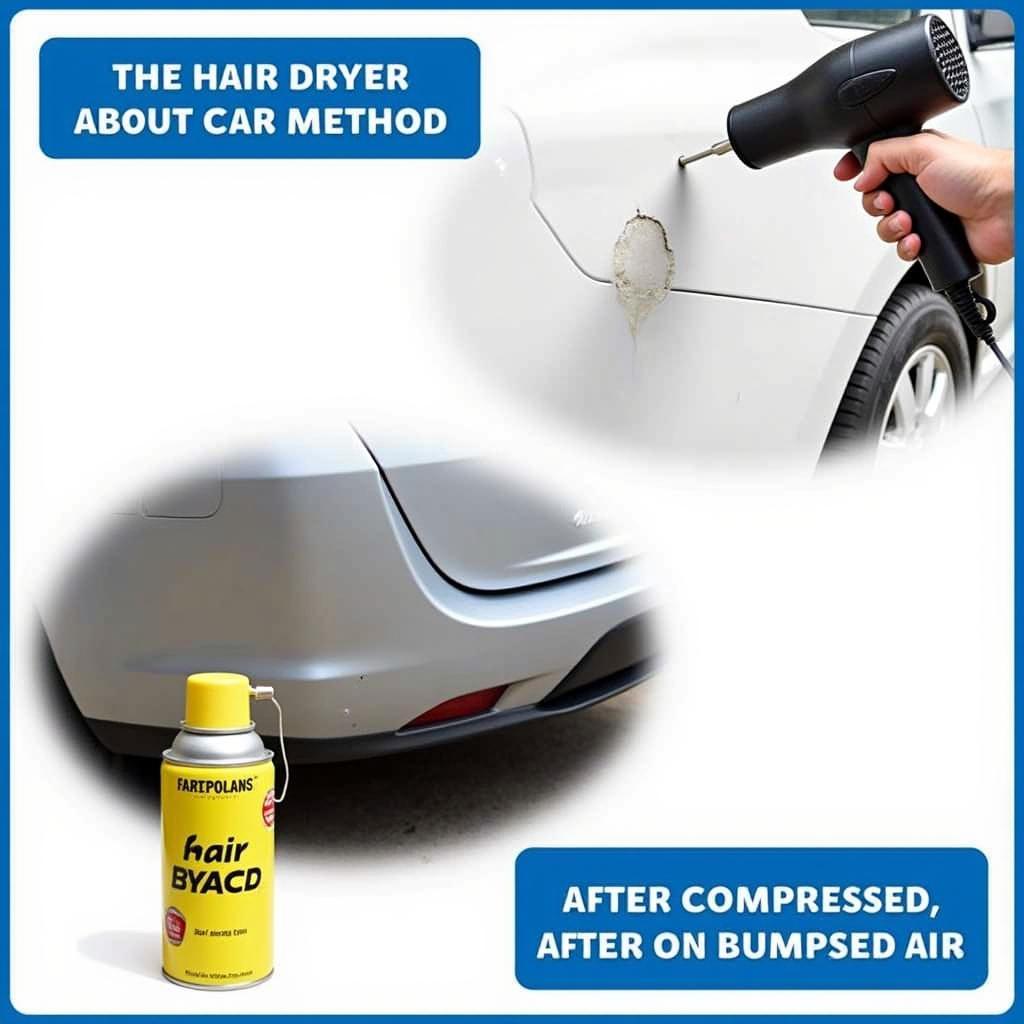Can you really fix a car dent with compressed air? This question pops up frequently online, sparking debates and DIY attempts. While the idea sounds appealingly simple, the reality is more nuanced. Let’s delve into the science and practicality of using compressed air for dent removal. After reading this article, you’ll have a clear understanding of this technique and its limitations. compressed air to fix car dents
Understanding the Physics of Dents
Before we explore the compressed air method, it’s crucial to understand how dents form. When a force impacts your car’s body, it deforms the metal, creating a depression. This deformation can be either elastic, meaning the metal springs back to its original shape, or plastic, meaning the metal retains the dent. Fixing a dent involves manipulating the metal back to its pre-dent state.
Can Compressed Air Really Fix Car Dents?
The short answer: sometimes. The effectiveness of compressed air for fixing car dents depends heavily on the type and severity of the dent. Small, shallow dents caused by minor impacts sometimes respond to this technique, especially when combined with other methods. However, significant dents or those involving creases require professional repair. Think of it like a crumpled piece of paper – you can smooth it out a bit, but you can’t fully restore its original flatness.
How to Attempt Dent Removal with Compressed Air (and When Not To)
For minor dents on plastic parts, like bumpers, using compressed air can sometimes work. The cold air can sometimes cause the plastic to contract, potentially popping the dent back out. However, this isn’t a guaranteed fix and may not work on all types of plastic.
Steps for attempting dent removal with compressed air on plastic parts:
- Clean the dented area thoroughly.
- Shake the can of compressed air well.
- Hold the can upside down and spray the dent from a distance of several inches. The key here is to use short bursts of cold air.
- Repeat the process a few times, checking the dent after each burst.
Important Note: Do not attempt this on metal panels. The rapid temperature change can damage the paint and even worsen the dent. For metal dents, seek professional help. Using fixing dent in car with compressed air can cause more issues than it resolves.
Alternative DIY Dent Removal Methods
If the compressed air method doesn’t work, or if you’re dealing with a metal dent, consider these alternative DIY methods:
- Hot Water and Plunger: Pouring hot water over the dent and then using a plunger can sometimes pull out shallow dents. This works best on larger, less defined dents.
- Hair Dryer and Compressed Air: This method combines the expansion caused by heat with the contraction caused by cold air. Heat the dent with a hair dryer, then quickly apply compressed air. This method can be effective for small, shallow dents on plastic bumpers. You can read more at fix car dent with hair dryer and compressed air.
 Hair Dryer and Compressed Air Dent Removal
Hair Dryer and Compressed Air Dent Removal
- Glue Pulling: Specialized glue pulling kits are available that allow you to pull out dents using adhesive tabs and a pulling device. This is a more advanced DIY method but can be quite effective for small to medium-sized dents.
When to Call a Professional
While DIY methods can be helpful for minor dents, more significant damage often requires professional repair. Deep dents, dents with sharp creases, or dents that have damaged the paint should be addressed by a qualified auto body technician. Remember, attempting to fix severe damage yourself could worsen the problem and lead to more costly repairs down the line.
 Professional Car Dent Repair
Professional Car Dent Repair
“Attempting complex dent repair without the proper tools and training can often lead to further damage,” says John Miller, an experienced auto body technician with over 20 years in the industry. “It’s always best to err on the side of caution and seek professional help for anything beyond minor cosmetic imperfections.”
Conclusion
Fixing a car dent with compressed air can be a tempting quick fix, but it’s essential to understand its limitations. While it might work for some small dents on plastic parts, it’s generally not effective for metal dents. fix car dents using hair dryer and compressed air. For anything beyond minor cosmetic blemishes, consulting a professional is the best approach.
We’re always here to help. Contact AutoTipPro at +1 (641) 206-8880 or visit our office at 500 N St Mary’s St, San Antonio, TX 78205, United States.
“Remember, a poorly repaired dent can significantly impact your car’s resale value,” adds Miller. “Investing in professional repair ensures the job is done right and preserves your vehicle’s worth.”
FAQ
-
Can compressed air fix dents on a metal car door? Generally, no. Compressed air is unlikely to fix metal dents and could damage the paint.
-
What’s the best way to fix a small dent on a plastic bumper? A hair dryer combined with compressed air, a plunger, or hot water can sometimes work.
-
When should I call a professional for dent repair? For deep dents, creases, or damage to the paint, always consult a professional.
-
Is it safe to use compressed air on painted surfaces? Extreme temperature changes can damage paint, so use caution.
-
What are the risks of DIY dent repair? Improper techniques can worsen the damage and increase repair costs.
-
How much does professional dent repair cost? The cost varies depending on the severity of the damage and the repair method used.
-
Can I use compressed air to fix a dent on my aluminum car? Similar to steel, compressed air is not recommended for aluminum dents and could cause further issues.





Leave a Reply